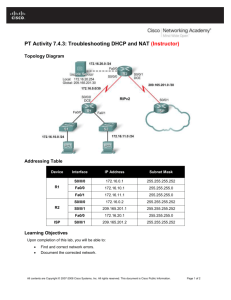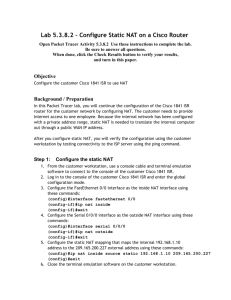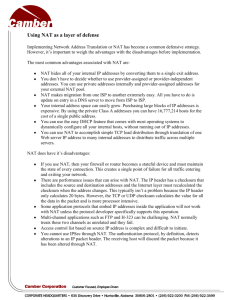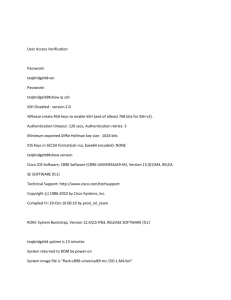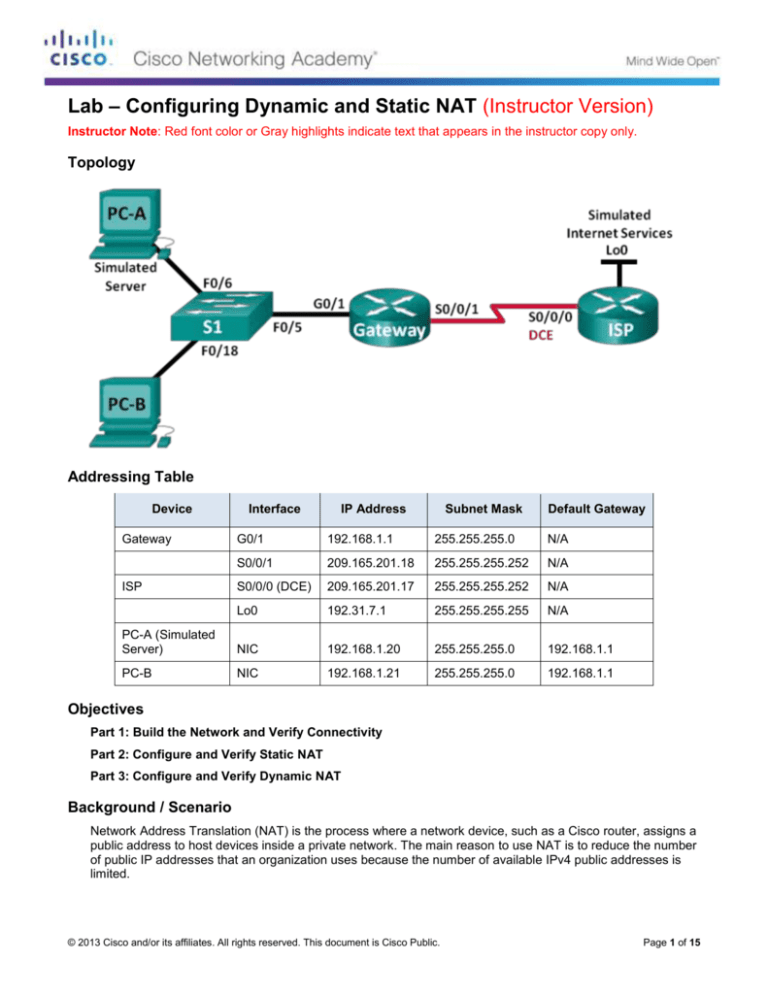
Lab – Configuring Dynamic and Static NAT (Instructor Version)
Instructor Note: Red font color or Gray highlights indicate text that appears in the instructor copy only.
Topology
Addressing Table
Device
Gateway
Interface
IP Address
Subnet Mask
Default Gateway
G0/1
192.168.1.1
255.255.255.0
N/A
S0/0/1
209.165.201.18
255.255.255.252
N/A
S0/0/0 (DCE)
209.165.201.17
255.255.255.252
N/A
Lo0
192.31.7.1
255.255.255.255
N/A
PC-A (Simulated
Server)
NIC
192.168.1.20
255.255.255.0
192.168.1.1
PC-B
NIC
192.168.1.21
255.255.255.0
192.168.1.1
ISP
Objectives
Part 1: Build the Network and Verify Connectivity
Part 2: Configure and Verify Static NAT
Part 3: Configure and Verify Dynamic NAT
Background / Scenario
Network Address Translation (NAT) is the process where a network device, such as a Cisco router, assigns a
public address to host devices inside a private network. The main reason to use NAT is to reduce the number
of public IP addresses that an organization uses because the number of available IPv4 public addresses is
limited.
© 2013 Cisco and/or its affiliates. All rights reserved. This document is Cisco Public.
Page 1 of 15
Lab – Configuring Dynamic and Static NAT
In this lab, an ISP has allocated the public IP address space of 209.165.200.224/27 to a company. This
provides the company with 30 public IP addresses. The addresses, 209.165.200.225 to 209.165.200.241, are
for static allocation and 209.165.200.242 to 209.165.200.254 are for dynamic allocation. A static route is used
from the ISP to the gateway router, and a default route is used from the gateway to the ISP router. The ISP
connection to the Internet is simulated by a loopback address on the ISP router.
Note: The routers used with CCNA hands-on labs are Cisco 1941 Integrated Services Routers (ISRs) with
Cisco IOS Release 15.2(4)M3 (universalk9 image). The switches used are Cisco Catalyst 2960s with Cisco
IOS Release 15.0(2) (lanbasek9 image). Other routers, switches and Cisco IOS versions can be used.
Depending on the model and Cisco IOS version, the commands available and output produced might vary
from what is shown in the labs. Refer to the Router Interface Summary Table at the end of this lab for the
correct interface identifiers.
Note: Make sure that the routers and switch have been erased and have no startup configurations. If you are
unsure, contact your instructor.
Instructor Note: Refer to the Instructor Lab Manual for the procedures to initialize and reload devices.
Required Resources
2 Routers (Cisco 1941 with Cisco IOS Release 15.2(4)M3 universal image or comparable)
1 Switch (Cisco 2960 with Cisco IOS Release 15.0(2) lanbasek9 image or comparable)
2 PCs (Windows 7, Vista, or XP with terminal emulation program, such as Tera Term)
Console cables to configure the Cisco IOS devices via the console ports
Ethernet and serial cables as shown in the topology
Part 1: Build the Network and Verify Connectivity
In Part 1, you will set up the network topology and configure basic settings, such as the interface IP
addresses, static routing, device access, and passwords.
Step 1: Cable the network as shown in the topology.
Attach the devices as shown in the topology diagram, and cable as necessary.
Step 2: Configure PC hosts.
Step 3: Initialize and reload the routers and switches as necessary.
Step 4: Configure basic settings for each router.
a. Disable DNS lookup.
b. Configure IP addresses for the routers as listed in the Addressing Table.
c.
Set the clock rate to 128000 for the DCE serial interfaces.
d. Configure device name as shown in the topology.
e. Assign cisco as the console and vty passwords.
f.
Assign class as the encrypted privileged EXEC mode password.
g. Configure logging synchronous to prevent console messages from interrupting the command entry.
Step 5: Create a simulated web server on ISP.
a. Create a local user named webuser with an encrypted password of webpass.
© 2013 Cisco and/or its affiliates. All rights reserved. This document is Cisco Public.
Page 2 of 15
Lab – Configuring Dynamic and Static NAT
ISP(config)# username webuser privilege 15 secret webpass
b. Enable the HTTP server service on ISP.
ISP(config)# ip http server
c.
Configure the HTTP service to use the local user database.
ISP(config)# ip http authentication local
Step 6: Configure static routing.
a. Create a static route from the ISP router to the Gateway router using the assigned public network address
range 209.165.200.224/27.
ISP(config)# ip route 209.165.200.224 255.255.255.224 209.165.201.18
b. Create a default route from the Gateway router to the ISP router.
Gateway(config)# ip route 0.0.0.0 0.0.0.0 209.165.201.17
Step 7: Save the running configuration to the startup configuration.
Step 8: Verify network connectivity.
a. From the PC hosts, ping the G0/1 interface on the Gateway router. Troubleshoot if the pings are
unsuccessful.
b. Display the routing tables on both routers to verify that the static routes are in the routing table and
configured correctly on both routers.
Part 2: Configure and Verify Static NAT
Static NAT uses a one-to-one mapping of local and global addresses, and these mappings remain constant.
Static NAT is particularly useful for web servers or devices that must have static addresses that are
accessible from the Internet.
Step 1: Configure a static mapping.
A static map is configured to tell the router to translate between the private inside server address
192.168.1.20 and the public address 209.165.200.225. This allows a user from the Internet to access PC-A.
PC-A is simulating a server or device with a constant address that can be accessed from the Internet.
Gateway(config)# ip nat inside source static 192.168.1.20 209.165.200.225
Step 2: Specify the interfaces.
Issue the ip nat inside and ip nat outside commands to the interfaces.
Gateway(config)# interface g0/1
Gateway(config-if)# ip nat inside
Gateway(config-if)# interface s0/0/1
Gateway(config-if)# ip nat outside
Step 3: Test the configuration.
a. Display the static NAT table by issuing the show ip nat translations command.
Gateway# show ip nat translations
Pro Inside global
--- 209.165.200.225
Inside local
192.168.1.20
Outside local
---
© 2013 Cisco and/or its affiliates. All rights reserved. This document is Cisco Public.
Outside global
---
Page 3 of 15
Lab – Configuring Dynamic and Static NAT
What is the translation of the Inside local host address?
192.168.1.20 = _________________________________________________________ 209.165.200.225
The Inside global address is assigned by?
____________________________________________________________________________________
The router from the NAT pool.
The Inside local address is assigned by?
____________________________________________________________________________________
The administrator for the workstation.
b. From PC-A, ping the Lo0 interface (192.31.7.1) on ISP. If the ping was unsuccessful, troubleshoot and
correct the issues. On the Gateway router, display the NAT table.
Gateway# show ip nat translations
Pro Inside global
Inside local
icmp 209.165.200.225:1 192.168.1.20:1
--- 209.165.200.225
192.168.1.20
Outside local
192.31.7.1:1
---
Outside global
192.31.7.1:1
---
A NAT entry was added to the table with ICMP listed as the protocol when PC-A sent an ICMP request
(ping) to 192.31.7.1 on ISP.
What port number was used in this ICMP exchange? ________________ 1, answers will vary.
Note: It may be necessary to disable the PC-A firewall for the ping to be successful.
c.
From PC-A, telnet to the ISP Lo0 interface and display the NAT table.
Pro Inside global
icmp 209.165.200.225:1
tcp 209.165.200.225:1034
--- 209.165.200.225
Inside local
192.168.1.20:1
192.168.1.20:1034
192.168.1.20
Outside local
192.31.7.1:1
192.31.7.1:23
---
Outside global
192.31.7.1:1
192.31.7.1:23
---
Note: The NAT for the ICMP request may have timed out and been removed from the NAT table.
What was the protocol used in this translation? ____________ tcp
What are the port numbers used?
Inside global / local: ________________ 1034, answers will vary.
Outside global / local: ________________ 23
d. Because static NAT was configured for PC-A, verify that pinging from ISP to PC-A at the static NAT public
address (209.165.200.225) is successful.
e. On the Gateway router, display the NAT table to verify the translation.
Gateway# show ip nat translations
Pro Inside global
Inside local
icmp 209.165.200.225:12 192.168.1.20:12
--- 209.165.200.225
192.168.1.20
Outside local
209.165.201.17:12
---
Outside global
209.165.201.17:12
---
Notice that the Outside local and Outside global addresses are the same. This address is the ISP remote
network source address. For the ping from the ISP to succeed, the Inside global static NAT address
209.165.200.225 was translated to the Inside local address of PC-A (192.168.1.20).
f.
Verify NAT statistics by using the show ip nat statistics command on the Gateway router.
Gateway# show ip nat statistics
Total active translations: 2 (1 static, 1 dynamic; 1 extended)
© 2013 Cisco and/or its affiliates. All rights reserved. This document is Cisco Public.
Page 4 of 15
Lab – Configuring Dynamic and Static NAT
Peak translations: 2, occurred 00:02:12 ago
Outside interfaces:
Serial0/0/1
Inside interfaces:
GigabitEthernet0/1
Hits: 39 Misses: 0
CEF Translated packets: 39, CEF Punted packets: 0
Expired translations: 3
Dynamic mappings:
Total doors: 0
Appl doors: 0
Normal doors: 0
Queued Packets: 0
Note: This is only a sample output. Your output may not match exactly.
Part 3: Configure and Verify Dynamic NAT
Dynamic NAT uses a pool of public addresses and assigns them on a first-come, first-served basis. When an
inside device requests access to an outside network, dynamic NAT assigns an available public IPv4 address
from the pool. Dynamic NAT results in a many-to-many address mapping between local and global
addresses.
Step 1: Clear NATs.
Before proceeding to add dynamic NATs, clear the NATs and statistics from Part 2.
Gateway# clear ip nat translation *
Gateway# clear ip nat statistics
Step 2: Define an access control list (ACL) that matches the LAN private IP address range.
ACL 1 is used to allow 192.168.1.0/24 network to be translated.
Gateway(config)# access-list 1 permit 192.168.1.0 0.0.0.255
Step 3: Verify that the NAT interface configurations are still valid.
Issue the show ip nat statistics command on the Gateway router to verify the NAT configurations.
Gateway# show ip nat statistics
Total active translations: 1 (1 static, 0 dynamic; 0 extended)
Peak translations: 0
Outside interfaces:
Serial0/0/1
Inside interfaces:
FastEthernet0/1
Hits: 0 Misses: 0
CEF Translated packets: 0, CEF Punted packets: 0
Expired translations: 0
Dynamic mappings:
Total doors: 0
© 2013 Cisco and/or its affiliates. All rights reserved. This document is Cisco Public.
Page 5 of 15
Lab – Configuring Dynamic and Static NAT
Appl doors: 0
Normal doors: 0
Queued Packets: 0
Step 4: Define the pool of usable public IP addresses.
Gateway(config)# ip nat pool public_access 209.165.200.242 209.165.200.254
netmask 255.255.255.224
Step 5: Define the NAT from the inside source list to the outside pool.
Note: Remember that NAT pool names are case-sensitive and the pool name entered here must match
that used in the previous step.
Gateway(config)# ip nat inside source list 1 pool public_access
Step 6: Test the configuration.
a. From PC-B, ping the Lo0 interface (192.31.7.1) on ISP. If the ping was unsuccessful, troubleshoot and
correct the issues. On the Gateway router, display the NAT table.
Gateway# show ip nat translations
Pro Inside global
--- 209.165.200.225
icmp 209.165.200.242:1
--- 209.165.200.242
Inside local
192.168.1.20
192.168.1.21:1
192.168.1.21
Outside local
--192.31.7.1:1
---
Outside global
--192.31.7.1:1
---
What is the translation of the Inside local host address for PC-B?
192.168.1.21 = _________________________________________________________ 209.165.200.242
A dynamic NAT entry was added to the table with ICMP as the protocol when PC-B sent an ICMP
message to 192.31.7.1 on ISP.
What port number was used in this ICMP exchange? ______________ 1, answers will vary.
b. From PC-B, open a browser and enter the IP address of the ISP-simulated web server (Lo0 interface).
When prompted, log in as webuser with a password of webpass.
c.
Display the NAT table.
Pro
--tcp
tcp
tcp
tcp
tcp
tcp
tcp
tcp
tcp
tcp
tcp
tcp
tcp
tcp
tcp
Inside global
209.165.200.225
209.165.200.242:1038
209.165.200.242:1039
209.165.200.242:1040
209.165.200.242:1041
209.165.200.242:1042
209.165.200.242:1043
209.165.200.242:1044
209.165.200.242:1045
209.165.200.242:1046
209.165.200.242:1047
209.165.200.242:1048
209.165.200.242:1049
209.165.200.242:1050
209.165.200.242:1051
209.165.200.242:1052
Inside local
192.168.1.20
192.168.1.21:1038
192.168.1.21:1039
192.168.1.21:1040
192.168.1.21:1041
192.168.1.21:1042
192.168.1.21:1043
192.168.1.21:1044
192.168.1.21:1045
192.168.1.21:1046
192.168.1.21:1047
192.168.1.21:1048
192.168.1.21:1049
192.168.1.21:1050
192.168.1.21:1051
192.168.1.21:1052
Outside local
--192.31.7.1:80
192.31.7.1:80
192.31.7.1:80
192.31.7.1:80
192.31.7.1:80
192.31.7.1:80
192.31.7.1:80
192.31.7.1:80
192.31.7.1:80
192.31.7.1:80
192.31.7.1:80
192.31.7.1:80
192.31.7.1:80
192.31.7.1:80
192.31.7.1:80
© 2013 Cisco and/or its affiliates. All rights reserved. This document is Cisco Public.
Outside global
--192.31.7.1:80
192.31.7.1:80
192.31.7.1:80
192.31.7.1:80
192.31.7.1:80
192.31.7.1:80
192.31.7.1:80
192.31.7.1:80
192.31.7.1:80
192.31.7.1:80
192.31.7.1:80
192.31.7.1:80
192.31.7.1:80
192.31.7.1:80
192.31.7.1:80
Page 6 of 15
Lab – Configuring Dynamic and Static NAT
--- 209.165.200.242
192.168.1.22
---
---
What protocol was used in this translation? ____________ tcp
What port numbers were used?
Inside: ________________ 1038 to 1052. Answers will vary
outside: ________________ 80
What well-known port number and service was used? ________________ port 80, www or http
d. Verify NAT statistics by using the show ip nat statistics command on the Gateway router.
Gateway# show ip nat statistics
Total active translations: 3 (1 static, 2 dynamic; 1 extended)
Peak translations: 17, occurred 00:06:40 ago
Outside interfaces:
Serial0/0/1
Inside interfaces:
GigabitEthernet0/1
Hits: 345 Misses: 0
CEF Translated packets: 345, CEF Punted packets: 0
Expired translations: 20
Dynamic mappings:
-- Inside Source
[Id: 1] access-list 1 pool public_access refcount 2
pool public_access: netmask 255.255.255.224
start 209.165.200.242 end 209.165.200.254
type generic, total addresses 13, allocated 1 (7%), misses 0
Total doors: 0
Appl doors: 0
Normal doors: 0
Queued Packets: 0
Note: This is only a sample output. Your output may not match exactly.
Step 7: Remove the static NAT entry.
In Step 7, the static NAT entry is removed and you can observe the NAT entry.
a. Remove the static NAT from Part 2. Enter yes when prompted to delete child entries.
Gateway(config)# no ip nat inside source static 192.168.1.20 209.165.200.225
Static entry in use, do you want to delete child entries? [no]: yes
b. Clear the NATs and statistics.
c.
Ping the ISP (192.31.7.1) from both hosts.
d. Display the NAT table and statistics.
Gateway# show ip nat statistics
Total active translations: 4 (0 static, 4 dynamic; 2 extended)
Peak translations: 15, occurred 00:00:43 ago
Outside interfaces:
Serial0/0/1
© 2013 Cisco and/or its affiliates. All rights reserved. This document is Cisco Public.
Page 7 of 15
Lab – Configuring Dynamic and Static NAT
Inside interfaces:
GigabitEthernet0/1
Hits: 16 Misses: 0
CEF Translated packets: 285, CEF Punted packets: 0
Expired translations: 11
Dynamic mappings:
-- Inside Source
[Id: 1] access-list 1 pool public_access refcount 4
pool public_access: netmask 255.255.255.224
start 209.165.200.242 end 209.165.200.254
type generic, total addresses 13, allocated 2 (15%), misses 0
Total doors: 0
Appl doors: 0
Normal doors: 0
Queued Packets: 0
Gateway# show ip nat translation
Pro Inside global
Inside local
icmp 209.165.200.243:512 192.168.1.20:512
--- 209.165.200.243
192.168.1.20
icmp 209.165.200.242:512 192.168.1.21:512
--- 209.165.200.242
192.168.1.21
Outside local
192.31.7.1:512
--192.31.7.1:512
---
Outside global
192.31.7.1:512
--192.31.7.1:512
---
Note: This is only a sample output. Your output may not match exactly.
Reflection
1. Why would NAT be used in a network?
_______________________________________________________________________________________
_______________________________________________________________________________________
_______________________________________________________________________________________
Answers will vary, but should include: whenever there are not enough public IP addresses and to avoid the
cost of purchasing public addresses from an ISP. NAT can also provide a measure of security by hiding
internal addresses from outside networks.
2. What are the limitations of NAT?
_______________________________________________________________________________________
_______________________________________________________________________________________
_______________________________________________________________________________________
NAT needs IP information or port number information in the IP header and TCP header of packets for
translation. Here is a partial list of protocols that cannot be used with NAT: SNMP, LDAP, Kerberos version 5.
© 2013 Cisco and/or its affiliates. All rights reserved. This document is Cisco Public.
Page 8 of 15
Lab – Configuring Dynamic and Static NAT
Router Interface Summary Table
Router Interface Summary
Router Model
Ethernet Interface #1
Ethernet Interface #2
Serial Interface #1
Serial Interface #2
1800
Fast Ethernet 0/0
(F0/0)
Fast Ethernet 0/1
(F0/1)
Serial 0/0/0 (S0/0/0)
Serial 0/0/1 (S0/0/1)
1900
Gigabit Ethernet 0/0
(G0/0)
Gigabit Ethernet 0/1
(G0/1)
Serial 0/0/0 (S0/0/0)
Serial 0/0/1 (S0/0/1)
2801
Fast Ethernet 0/0
(F0/0)
Fast Ethernet 0/1
(F0/1)
Serial 0/1/0 (S0/1/0)
Serial 0/1/1 (S0/1/1)
2811
Fast Ethernet 0/0
(F0/0)
Fast Ethernet 0/1
(F0/1)
Serial 0/0/0 (S0/0/0)
Serial 0/0/1 (S0/0/1)
2900
Gigabit Ethernet 0/0
(G0/0)
Gigabit Ethernet 0/1
(G0/1)
Serial 0/0/0 (S0/0/0)
Serial 0/0/1 (S0/0/1)
Note: To find out how the router is configured, look at the interfaces to identify the type of router and how many
interfaces the router has. There is no way to effectively list all the combinations of configurations for each router
class. This table includes identifiers for the possible combinations of Ethernet and Serial interfaces in the device.
The table does not include any other type of interface, even though a specific router may contain one. An
example of this might be an ISDN BRI interface. The string in parenthesis is the legal abbreviation that can be
used in Cisco IOS commands to represent the interface.
Device Configs
Gateway (After Part 2)
Gateway# show run
Building configuration...
Current configuration : 1666 bytes
!
version 15.2
service timestamps debug datetime msec
service timestamps log datetime msec
no service password-encryption
!
hostname Gateway
!
boot-start-marker
boot-end-marker
!
!
enable secret 4 06YFDUHH61wAE/kLkDq9BGho1QM5EnRtoyr8cHAUg.2
!
no aaa new-model
memory-size iomem 15
!
!
© 2013 Cisco and/or its affiliates. All rights reserved. This document is Cisco Public.
Page 9 of 15
Lab – Configuring Dynamic and Static NAT
!
!
!
!
!
no ip domain lookup
ip cef
no ipv6 cef
multilink bundle-name authenticated
!
!
!
!
!
!
!
!
!
!
!
interface Embedded-Service-Engine0/0
no ip address
shutdown
!
interface GigabitEthernet0/0
no ip address
shutdown
duplex auto
speed auto
!
interface GigabitEthernet0/1
ip address 192.168.1.1 255.255.255.0
ip nat inside
ip virtual-reassembly in
duplex auto
speed auto
!
interface Serial0/0/0
no ip address
shutdown
clock rate 2000000
!
interface Serial0/0/1
ip address 209.165.201.18 255.255.255.252
ip nat outside
ip virtual-reassembly in
!
ip forward-protocol nd
!
© 2013 Cisco and/or its affiliates. All rights reserved. This document is Cisco Public.
Page 10 of 15
Lab – Configuring Dynamic and Static NAT
no ip http server
no ip http secure-server
!
ip nat inside source static 192.168.1.20 209.165.200.225
ip route 0.0.0.0 0.0.0.0 209.165.201.17
!
!
!
!
control-plane
!
!
!
line con 0
password cisco
logging synchronous
login
line aux 0
line 2
no activation-character
no exec
transport preferred none
transport input all
transport output pad telnet rlogin lapb-ta mop udptn v120 ssh
stopbits 1
line vty 0 4
password cisco
login
transport input all
!
scheduler allocate 20000 1000
!
end
Gateway (Final)
Gateway# show run
Building configuration...
Current configuration : 1701 bytes
!
version 15.2
service timestamps debug datetime msec
service timestamps log datetime msec
no service password-encryption
!
hostname Gateway
!
boot-start-marker
boot-end-marker
© 2013 Cisco and/or its affiliates. All rights reserved. This document is Cisco Public.
Page 11 of 15
Lab – Configuring Dynamic and Static NAT
!
!
enable secret 4 06YFDUHH61wAE/kLkDq9BGho1QM5EnRtoyr8cHAUg.2
!
no aaa new-model
memory-size iomem 15
!
!
!
!
!
!
!
no ip domain lookup
ip cef
no ipv6 cef
multilink bundle-name authenticated
!
!
!
!
!
!
!
!
!
interface Embedded-Service-Engine0/0
no ip address
shutdown
!
interface GigabitEthernet0/0
no ip address
shutdown
duplex auto
speed auto
!
interface GigabitEthernet0/1
ip address 192.168.1.1 255.255.255.0
ip nat inside
ip virtual-reassembly in
duplex auto
speed auto
!
interface Serial0/0/0
no ip address
shutdown
clock rate 2000000
!
interface Serial0/0/1
© 2013 Cisco and/or its affiliates. All rights reserved. This document is Cisco Public.
Page 12 of 15
Lab – Configuring Dynamic and Static NAT
ip address 209.165.201.18 255.255.255.252
ip nat outside
ip virtual-reassembly in
!
ip forward-protocol nd
!
no ip http server
no ip http secure-server
!
ip nat pool public_access 209.165.200.242 209.165.200.254 netmask 255.255.255.224
ip nat inside source list 1 pool public_access
ip route 0.0.0.0 0.0.0.0 209.165.201.17
!
access-list 1 permit 192.168.1.0 0.0.0.255
!
!
!
control-plane
!
!
!
line con 0
password cisco
logging synchronous
login
line aux 0
line 2
no activation-character
no exec
transport preferred none
transport input all
transport output pad telnet rlogin lapb-ta mop udptn v120 ssh
stopbits 1
line vty 0 4
password cisco
login
transport input all
!
scheduler allocate 20000 1000
!
end
ISP (Final)
ISP# show run
Building configuration...
Current configuration : 1557 bytes
!
! Last configuration change at 09:16:34 UTC Sun Mar 24 2013
© 2013 Cisco and/or its affiliates. All rights reserved. This document is Cisco Public.
Page 13 of 15
Lab – Configuring Dynamic and Static NAT
version 15.2
service timestamps debug datetime msec
service timestamps log datetime msec
no service password-encryption
!
hostname ISP
!
boot-start-marker
boot-end-marker
!
!
enable secret 4 06YFDUHH61wAE/kLkDq9BGho1QM5EnRtoyr8cHAUg.2
!
no aaa new-model
memory-size iomem 10
!
!
!
!
!
!
no ip domain lookup
ip cef
no ipv6 cef
multilink bundle-name authenticated
!
!
!
!
!
username webuser privilege 15 secret 4 ZMYyKvmzVsyor8jHyP9ox.cMoz9loLfZN75illtozY2
!
!
!
!
!
interface Loopback0
ip address 192.31.7.1 255.255.255.255
!
interface Embedded-Service-Engine0/0
no ip address
shutdown
!
interface GigabitEthernet0/0
no ip address
shutdown
duplex auto
speed auto
!
© 2013 Cisco and/or its affiliates. All rights reserved. This document is Cisco Public.
Page 14 of 15
Lab – Configuring Dynamic and Static NAT
interface GigabitEthernet0/1
no ip address
shutdown
duplex auto
speed auto
!
interface Serial0/0/0
ip address 209.165.201.17 255.255.255.252
clock rate 128000
!
interface Serial0/0/1
no ip address
shutdown
!
ip forward-protocol nd
!
ip http server
ip http authentication local
no ip http secure-server
!
ip route 209.165.200.224 255.255.255.224 209.165.201.18
!
!
!
control-plane
!
!
!
line con 0
password cisco
logging synchronous
login
line aux 0
line 2
no activation-character
no exec
transport preferred none
transport input all
transport output pad telnet rlogin lapb-ta mop udptn v120 ssh
stopbits 1
line vty 0 4
password cisco
login
transport input all
!
scheduler allocate 20000 1000
!
end
© 2013 Cisco and/or its affiliates. All rights reserved. This document is Cisco Public.
Page 15 of 15

